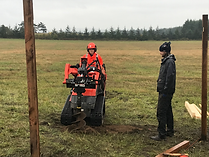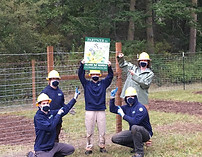San Juan Islands Conservation District
San Juan County, Washington

Island Marble Butterfly
The endangered island marble butterfly (Euchloe ausonides insulanus) was rediscovered 25 years ago. Since that time, it has declined to a single known population. Only 200–500 individuals are thought to remain. The San Juan Islands are the only place in the world where this butterfly can be found. Whether you own a small or much larger field or grassland, we can help you provide island marble butterfly habitat to help prevent extinction.
Technical Assistance
Are you interested in adding island marble butterfly habitat to your property? Our staff provide an assessment of habitat conditions on your property to help determine recommended management actions that can help meet your objectives. The San Juan Islands Conservation District provides free technical assistance to help landowners like you provide habitat for this rare butterfly. Click the assistance button on the right to contact us and begin stewarding habitat for the island marble butterfly today!
To learn more about providing island marble butterfly habitat, contact Walt Andrews at walt@sjicd.org
More Information



Photo credits left to right: new habitat plot construction, Walt Andrews; seeding host plants, Mike Rosekrans; host plants in spring, Sam Martin, Ecostudies Institute.
Providing Habitat on Your Property
Suitable habitats consist of open field or grassland areas with well drained soils for host plants. Habitat plots are built using deer fencing to protect host plants, eggs, and larvae from browsing deer and island marble chrysalises from disturbance. Native nectar plants are also planted as part of these habitat projects. Projects can range in size from approximately 1,000 to 6,000 square feet or larger. Request assistance now to schedule a site visit!
Get Involved
Get involved in island marble butterfly species recovery by linking island marble butterfly habitat on your property with a growing network of habitat plots on San Juan and Lopez islands:
-
Approximately 13 Partners for Fish and Wildlife plots and about 20 Candidate Conservation Agreement with Assurances plots have been built and maintained on San Juan and Lopez Islands
-
37,500 square feet fenced habitat conserved through the Partners for Fish and Wildlife program
-
146 acres conserved for island marble butterfly movement and dispersal on properties where Partners and Fish and Wildlife plots are located.



Photo credits left to right: tilling for host and nectar plants, Tyler Porter, USFWS; Brassica rapa host plants, Walt Andrews; students adding soil for host plants, Walt Andrews.
I'd like to request technical assistance. What happens next?
Here are the steps involved:
-
Contact Walt Andrews at walt@sjicd.org to schedule a site visit. Walt is the Natural Resource Project Manager for the island marble butterfly. He can provide you with a habitat assessment and answer any questions you may have about hosting habitat;
-
A site visit will help determine if island marble butterfly habitat is a good fit for your property:
-
If suitable habitat is available, a landowner agreement can then be signed. Financial assistance with habitat construction and initial plot maintenance are available; and
-
Habitat plots will then be built and host plants will be grown alongside native pollinator plants.
What are the ten ways SJICD can help you? Click here!



Photo credits left to right: post holes for a new deer fence, Walt Andrews; plot completed, WA Conservation Corps (WCC); host plants at same plot built by WCC, Sam Martin, Ecostudies Institute.
Partners for Fish and Wildlife Program
-
The US Fish and Wildlife Service's Partners for Fish and Wildlife program works with landowners to conserve and improve wildlife habitat. Conservation is voluntary and customized to meet landowners' needs.
-
The program is being used now to establish new habitat for the island marble butterfly since the species was listed as endangered by the US Fish and Wildlife Service in 2020.
Community Partnerships
Island marble butterfly partners include: many private landowners, US Fish and Wildlife, WA Department of Fish and Wildlife, National Parks Service, WA Department of Natural Resources, San Juan Preservation Trust, San Juan County Land Bank, and On Sacred Ground.
Additional Information—Nectar Plants and Pollinator Meadows
In addition to host plants, the island marble butterfly and other pollinators rely on floral nectar. What can you do to provide food and nesting habitat? There are several strategies provided below that you can follow to do this in your own yard or field. Find the method that works best for you and your land. Contact Walt Andrews at walt@sjicd.org to learn more about how you can plant your own pollinator meadow and protect nesting habitat for butterflies and bees.



Photo credits: Walt Andrews
Meadow Plantings
Plant a beautiful meadow with plenty of wildflowers for native butterflies and bees
-
Pick part of your yard or a field that is well-drained and has plenty of sunshine
-
Use weed-barrier to get rid of grasses and unwanted plants to create a seed bed
-
Plant native plants that are locally or regionally available
-
You can also plant non-native plants that are popular with butterflies and bees
Meadow Restoration
Restore native wildflowers and grasses to the San Juan Islands on your own property
-
Best option if your property is a already part of a remnant prairie ecosystem
-
Weed out non-native and invasive plants, especially non-native annual grasses
-
Plant native plants in exposed, well-drained soils where native plants are already growing
Pollinator Strips
Add a row of native plants to your garden or a swath of pollinator plants to your field
-
Best for sites that could use more flowering plant species or native wildflowers
-
Compatible with existing gardens, field crops, grazing, and hay fields
Conservation Grazing
Seed more native or non-native flower resources for nectar and bee pollen into your field
-
Includes adding clover and other leguminous plants like Trefoil
-
Compatible with grazing, haying, and native plant restoration
Trees and Shrubs for Pollinators
Don’t forget to plant important flowering trees and shrubs in your garden, yard, or field margins
-
Add flowering trees and shrubs to create patches of habitat or hedges for native pollinators
-
Compatible with wide variety of management goals such as fruit production or riparian restoration
Pollinator Nesting Habitat
Don’t forget to plant important flowering trees and shrubs in your garden, yard, or field margins
-
70% of all native bees are ground-nesting
-
Protect bare ground for ground-nesting bees
-
30% of all native bees are cavity-nesting
-
Protect dead wood, hollow stems, and brush piles for cavity-nesting wild bees
-
Leave buffers of grass at yard and field edges undisturbed to protect pollinators overwintering in the grass
Recommended Reading
Volunteer Opportunities
Island Marble Butterfly 101
Species Recovery Plan


